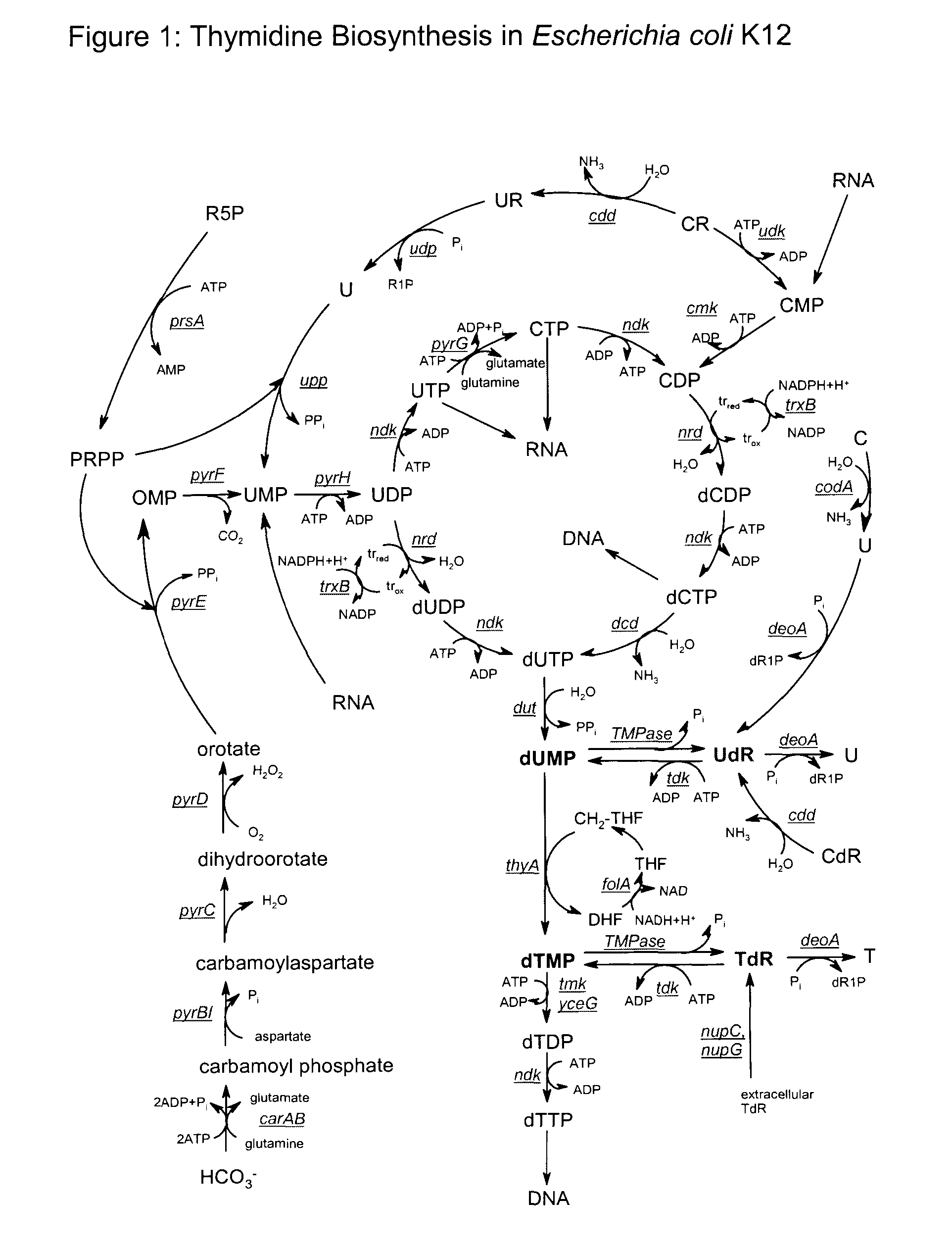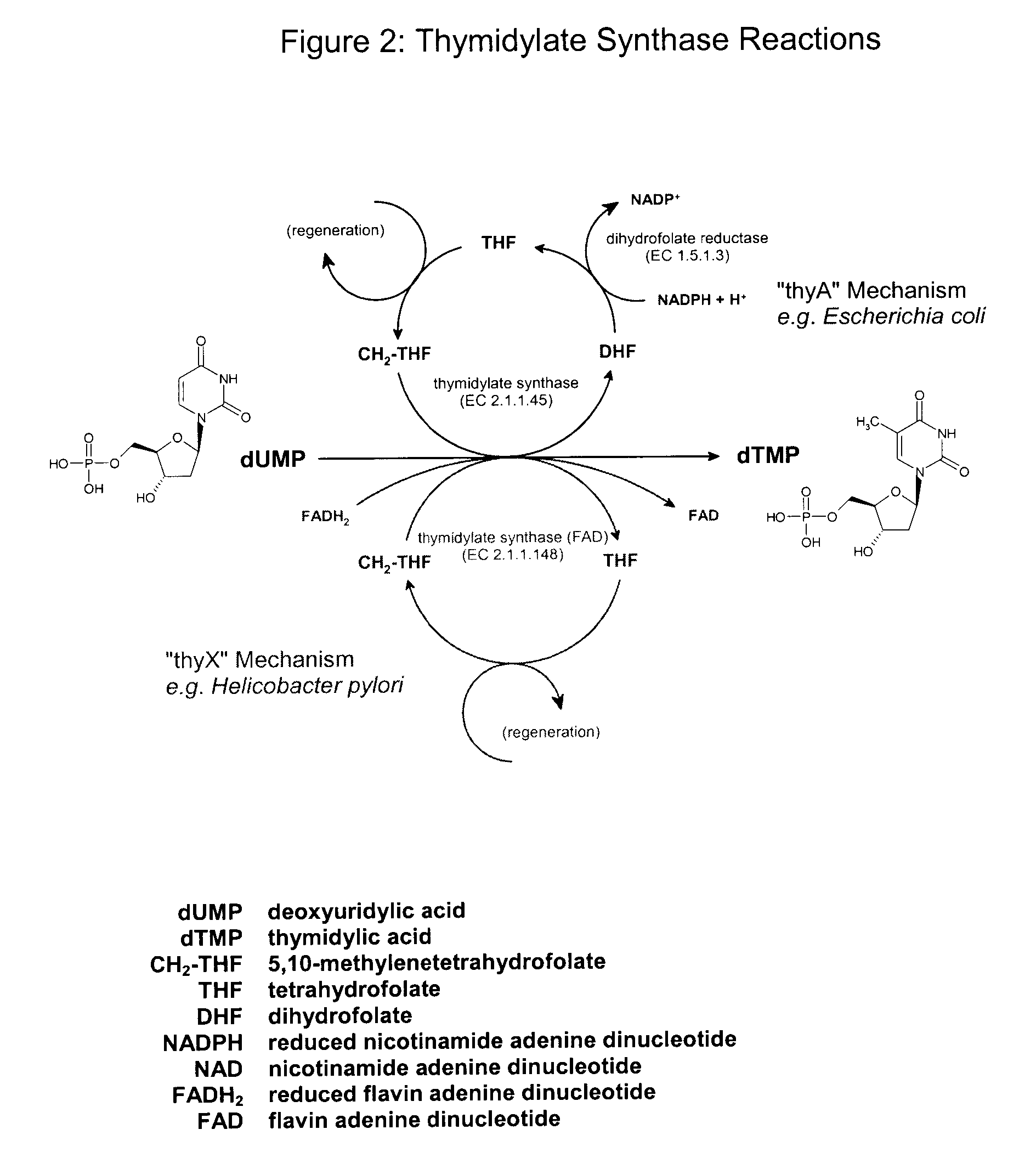Biological production of thymidine
a technology of thymidine and thymidine, which is applied in the direction of enzymology, drug compositions, transferases, etc., can solve the problems of significant rate limiting steps and limitation cannot be relieved, and achieve the effects of preventing the loss of plasmids, small increase, and loss of viability of plasmid-free cells
- Summary
- Abstract
- Description
- Claims
- Application Information
AI Technical Summary
Benefits of technology
Problems solved by technology
Method used
Image
Examples
example 2
Shake-Flask Test for Thymidine Production
[0088]The construct and strain referred to in Example 1 were grown in culture medium (Table 2) according to the following methodology. Data were obtained for comparative purposes on both the rate of TdR production and the relative amount of UdR impurity (expressed as a percentage of TdR).
[0089]All experiments were conducted in 250 mL baffled shake flasks with seven to twelve flasks per tested strain. A fresh seed culture grown in LB medium was used to inoculate 20 mL of medium per flask with about 2.5% volume. Cultures were grown at 31° C. until OD 600 nm=5. The temperature was then shifted from 35.7° to 36.8° C. by moving the flasks to a different shaker. Samples were taken for analysis at 4 to 6 hours post temperature induction.
[0090]
TABLE 2Enriched Shake Flask Medium FormulationComponentQuantity g / LPotassium phosphate, dibasic8.0Potassium phosphate, monobasic8.0Magnesium sulfate, heptahydrate0.4Ammonium Sulfate2.0Citric acid, trisodium dih...
example 3
Development of Improved Host E. coli Strain CMG2576 from CMG2451
[0093]The host strain was modified through a series of steps as listed in Table 4 below. There were three significant changes overall, although it will be appreciated that none of these form an essential part of the present invention. In the Examples below, intermediate strains CMG2549 and CMG2560 as well as final strain CMG2576 are used to demonstrate aspects of the invention.
[0094]Strain CMG2549 differs from CMG2451 in that the chromosomal ndk gene has been knocked out by replacement with an insertionally inactivated ndk::kan. This change was made to improve the overall production of pyrimidine nucleosides according to the principles taught by U.S. Pat. No. 5,213,972 and is important to the demonstration of the utility of the present invention detailed in Example 7.
[0095]CMG2560 was constructed by eliminating a lambda prophage from the chromosome, at the same time repairing mutations causing requirements for biotin an...
example 4
Development of Improved Construct, pCG609, from pCG532
[0099]The construct was modified through a series of steps as outlined below:
[0100]
[0101]More specifically, the genes were derived as illustrated in Table 5 below. Plasmids pCG532 and pCG609 are illustrated by FIGS. 6 and 7 respectively, where the main features may be compared.
[0102]Of the three changes made to the construct only the T4 frd gene forms an essential part of one embodiment of the present invention. The effect of this modification is illustrated by Examples 6 and 7 below. The remaining changes were made to prevent loss of plasmid from the host strain, as detailed in Example 8 below.
[0103]
TABLE 5Development of pCG609 from Prior Art Construct pCG532PlasmidGenes AddedDerivationpCG532Prior art construct includes:disclosed in detail in WO 01 / 02580T4 nrdCAB, td,(λPL promoter)E. coli udk, dcdpCG590T4 frd cloned into pCG532T4 frd subcloned from pCG581(see Example 5)pCG596λ cI857 cloned into pCG590moved from host strainchromo...
PUM
| Property | Measurement | Unit |
|---|---|---|
| weight | aaaaa | aaaaa |
| weight | aaaaa | aaaaa |
| weight | aaaaa | aaaaa |
Abstract
Description
Claims
Application Information
 Login to View More
Login to View More - Generate Ideas
- Intellectual Property
- Life Sciences
- Materials
- Tech Scout
- Unparalleled Data Quality
- Higher Quality Content
- 60% Fewer Hallucinations
Browse by: Latest US Patents, China's latest patents, Technical Efficacy Thesaurus, Application Domain, Technology Topic, Popular Technical Reports.
© 2025 PatSnap. All rights reserved.Legal|Privacy policy|Modern Slavery Act Transparency Statement|Sitemap|About US| Contact US: help@patsnap.com



